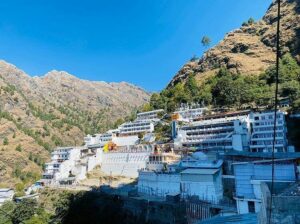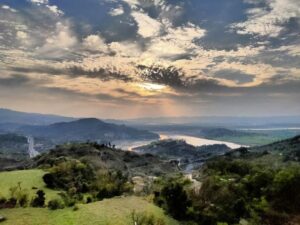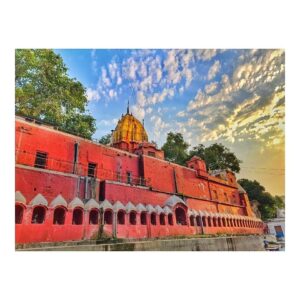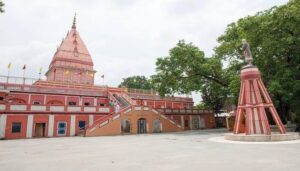Table of Contents
We are all familiar with very popular union territory i.e. Jammu and Kashmir. Jammu and Kashmir, also known as J&K had a special position in the Indian constitution under article 370. It gives a special power to residents of it with a different set of rules for the ownership of property.
Although J&K has gone through many terrorist attacks but the beauty of this place cannot be kept aside. J&K has always been well known for its beauty in Kashmir. Most of us may not know that Kashmir is somewhere different from Jammu. Due to the beauty of it, Kashmir is also known as heaven on earth. Not only this, but Jammu is also known as ‘The city of temples.’ As the name given to it, Jammu is well known for some of the incredible holy places in it.
In this article, I will be telling you about the most interesting and exciting holy places that one must see while having a trip to Jammu.
Before this let me tell you a very interesting story behind Jammu. The place got its name after Suryavanshi Jambu Lochan. He was the brother of Bahu who was the powerful king who ruled in the ninth century. When Jambu become the ruler and went on hunting, he saw a deer and a lion drinking water from the same river i.e. Tawi. While having a word with his ministers, he got to know that the soil of the place has such a moral standard that no living being has a feeling of opposition to each other. So, Raja Jambu Lochan, build his capital, which was named Jambupura, on that soil which was at the right bank of the Tawi. Jambupura later came to be known as Jammu. So this is how this place got its name as Jammu.
As the soil of this place is so virtuous and its such amazing historical facts let us learn about some of the very fascinating holy places in Jammu. These places are amazing and at the same time are very relaxing.
1. VAISHNO DEVI TEMPLE
So the first one is the very famous Shri Mata Vaishno Devi Temple. This famous temple is located in Katra which is 43 kms away from Jammu. This temple is built under the Shrine Board. The famous temple is situated in Trikuta Mountains in Katra. To reach the temple, people have to travel from the base camp of Katra and has to reach the temple. People can walk, or take horses on rent or can go by air.

For elder or disabled people the facility of travelling by air is also available. Electric cars and different rest houses, lockers, and many other services are also available.
HISTORY
Before telling you some of the facts about this place, let me tell you about what is the story behind such a wonderful place. It is said that, at the time of Tetra Yug, goddess Lakshmi, Gauri, and Sarasvati created goddess Vaishnavi by combining their energies for destroying the demons on Mother Earth. Goddess Vaishnavi was born as a human on earth.
From her childhood, she was very devotee to Lord Vishnu. At the age of her marriage, she left her house to perform intense austerities to please Lord Vishnu and win him as her husband.
At that time there was a devotee of Mata Vaishnavi ‘Sridhar’. He was very poor but at the same time, he was a big devotee of the goddess. It is said that one day in his dream Mata Vaishnavi came, and she asked him to organize a community meal (Bhandara) for all the villagers. Sridhar did the same, he organizes Bhandara despite having a small house and no money for organizing it. He invited the whole village along with many Gurus including Bhairon Nath.
The day before the Bhandara, he was very tensed with the problem of how to feed his guests and how to accommodate them in a small house. In the morning he sits down for his puja and resigned himself to fate. During midday, all the villagers along with Bhairon and the girl Vaishnavi arrive at their house. To very surprise every villager was able to be sit in his small hut and also some extra space was leftover.
When Sridhar completed his Puja, he was very surprised to see that whole of the food is already prepared. He believed that all this has been done by the goddess Vaishnavi. And also start wondering that all this has been done by the little girl Vaishnavi.
Bhairon was very surprised seeing all the magic that happens and was curious to know more about the girl. When he tried to hold the girl, she just disappeared and reach the cave. Their she started meditating hiding from Bhairon Nath. Bhairon Nath was so curious that he did not stop following her and finally he reached to her. When the goddess knew that he had found her and will destroy her meditation. She got angry with him and had to kill him. So she came out from the other side of the cave and she cut her face from her body. After this Bhairon realizes the mistake that he made, and requested the goddess to forgive him.
After some time, the same girl came to his dream and showed him the cave, and blessed him with four kids. After this, he was very happy and visited the cave. He decided to devote is the rest of his life to taking care of the cave. So, this is the story behind Shri Mata Vaishno Devi University.
AMAZING FACTS
- Vaishno Mata Cave is15km away from the base camp of Katra.
- Mata Vaishno Devi is also known as Goddess of a lion. It is said that Vaishnavi Goddess is always found sitting on a lion.
- Many times it is said that the people who visited the place or we can say the ‘Yatris’, have seen the lion over the area.
- When Vaishnavi was going into the cave, she wanted to wash her head. So she used a bow and arrow, pointed towards the earth and their River Ganga arrived. The place is known as Ban Ganga.
- As the cave is on a mountain, obviously the journey towards it is very tiring. It is also said that if the people wash their feet in ban Ganga or just use the water to clean their faces or feet or hand, it helps in the tiredness of the people.
- Also, there is a temple created across the real footprints of Mata Vaishno.
- There are many small temples of many gods and goddesses found at the Vaishnavi Temple.
- Also, it is believed that when Mata Vaishnavi was just about to enter the cave she met with god Hanuman, and told him to look after the cave as she was going in for meditation. So before fighting with Mata Vaishnavi, Bhairon Nath had to fight with Hanuman Ji.
- When Mata Vaishno cut the face of Bhairon from his body, his face was fallen at one side and his body to the other side.
- The face is believed to become a stone, which has been kept in the Bhairon mandir situated near the Vaishnavi temple.
- Also when Mata Vaishno forgives Bhairon, she gives him a boon that the people or the devotees who will come to worship her will have to visit his temple also.
- As this temple is located in the beautiful Trikuta mountains, there is the very beautiful scenery that can be viewed here. Also, people can do a kind of tracking here.
- In the cave, there are three Pindies which are the symbol of the power of Goddess Lakshmi, Saraswati, and Gauri.
- It is also believed that this cave has the darshanas of 33 crores gods and goddesses and they have left their symbolic marks inside. Also, it is said that during the time of morning and evening Pooja, all the gods and goddesses arrive to pay obeisance to the mother goddess.
2. MANSAR LAKE
The next one which we will learn about is the Mansar lake. This lake is just not like other ordinary lakes. This lake can be called as a site where god lives. Mansar lake is also a very beautiful location surrounded by forests. It is one of the most famous tourism destinations in India. The lake is also known as the Mansarovar Lake. Mansar can be reached via national highways while travelling from Jammu to Punjab. Surinsar is another small lake that is connected to Mansar Lake.

HISTORY
The history of this lake is back from the time of Mahabarata. The story of 5 Pandavas and Kauravas. It is said that the son of Arjun and Ulpi ‘Babar Vahan’ was the ruler of that region at the time of Mahabarata. Arjun didn’t know about his son Babar Vahan. At post time of war, Arjuna performed the Yagya over the land, which was named as Ashwamegh Yagya.
The horse was the main power symbol of Ashwamegh Yagya. The horse was captured by Babar Vahan at Village named Khoon near village Ramkot that is on Dhar Udhampur road. Here Arjun was killed by his son Babar as he didn’t know that Arjun was his father. Now Barbar wanted to celebrate his victory with his mother. So he decided to present the head of Arjun to his mother as a symbol of his success.
At the time when he presented the head to his mother, his mother told him the truth that Arjun was his father. When Babar gets to know the truth, he wanted to bring Arjun back to life. So for this, he needs to get the Mani from Sheshnag.
So Babar from his arrow made a tunnel which was known as Surangsar and not it is known as Surinsar. When he defeated Sheshnag and achieve Mani, he came out from the other end of the tunnel known as Manisar. Manisar is now known as Mansar. The tunnels were then filled and become Surinsar and Mansar.
AMAZING FACTS
- Besides, the lake other main attractions of this place are Flora and Fauna. This lake has various fishes and also a small type of wildlife sanctuary is located where we can see a lot of spotted deers, Neelgai, etc.
- A temple of Sheshnag, God of snakes, is located on the banks of the lake. It is believed that if a newlywed couple wants to take blessings of Sheshnaag, they need to complete three circular rounds of the lake.
- It is also believed that a dip in Mnasar Lake washes our previous sins.
- There are three more temples of Goddess Durga, Narasimha, and Parvathi Shiva.
- Various Hindu communities perform the MUNDAN ceremony i.e the ritual of the first hair cut of their male children.
3. MACHAIL MATA
Machail Mata is the temple of Goddess Durga which is popularly known as Machail Mata, located in the village Machail. It is basically in Kishtwar District of Jammu region in India. Goddess Durga is also known by the name as Kaali or Chandi. This temple is located at a high altitude of Himalayas and therefore the weather is a bit colder than usual. The temple is around 306 km away from Jammu.

HISTORY
History of this temple is related with the time of Zorawar Singh Kahluria. It is said that in 1834 he received blessings of Machail Mata, before crossing the mountains and Suru River (Indus), while going for conquering an army of local Botis of Ladakh. When he succeeded in his mission, he became a faithful devotee of Machail Mata. Machail Mata temple is also well known for its beauty. It has a landscape of unblemished beauty with hills, glaciers and tributaries of the Chenab River (Chadrabhaga). This place is basically a home to bhot and the Thakur community. They were serpent worshipers and was merged with Kishtwar tehsil, by Maharaja Ranbir Singh. It was by Thakur Kulveer Singh of Bhaderwah, Jammu region in 1981. From 1987 onwards, Thakur Kulveer Singh started ‘Chhadi Yatra’. This yatra happens every year and thousands of people visit the Machal Mata every year during ‘Chhadi Yatra’. Chhadi Yatra started from Chinote in Bhaderwah to Machail in Paddar. There are various supernatural happenings that are experienced by pilgrims and are reported.
HOW TO REACH
To reach the temple, a lot of people arrange buses from Jammu, Udhampur, Ramnagar, Bhaderwah. It has a journey of approximately 10 hours by road from Jammu to Gulabgarh. The distance is 290 km from Jammu to Gulabgarh. The Gulabgarh is the base camp of the temple.
The foot journey starts from Gulabgarh which is about 32 km. Usually, people take 2 days to reach the temple. On the way there are many villages, or small houses where one can stay in the night. The chaddi yatra takes three days to reach the temple. Lot of roadside free food points ‘langers’ are arranged by the people on the way to the Gulabgarh. During the months of December, January and February, the devotees are not able to visit the temple. Other mean of reaching the shrine is by taking a helicopter from Jammu and Gulabgarh. The helipad is only 100 meters from the shrine.
4. BAHU FORT
Bahu Fort is the most ancient fort in Jammu. It is situated at 5km from the main city centre. The fort is located at the banks of the Tawi river. The fort is locally known as the BAWE WALI MATA. The temple is dedicated to Hindu Goddess Kali. There are many small temples of different gods and goddesses created under the fort.

HISTORY
This temple or we can say that this fort was created 3000 years ago by Bahu Lochan brother of Jambu Lochan. After bahu, this fort was first renovated in the 18th century by Maharaja Ranjit Singh during the Sikh Rule. The present fort was recently improved and was extended by Dogra rulers. And inside the fort, there is a temple of goddess Kali. The fort represents a large number of Dogra kings.
AMAZING FACTS
- Another important feature that is seen here is the large group of Rhesus Monkeys. The monkeys are fed by the devotees with sweets, grams, etc.
- During the time of Navratras, the place is full of the presence of the devotees especially at the time of aarti.
- The fort was first reconstructed by Avtar Dev, grandson of Kapoor Dev.
- It has 8 octagonal towers connected by thick walls.
- There is a water pond located on the left entry into the fort.
- On the right side of the temple, there were some halls used as assembly halls in the past.
- It owns a royal garden called as Bagh-e-bahu.
- It also has a beautiful fish aquarium which is an important attraction.
5. PURMANDAL
PUrmandal temple is located in a small village of pUrmandal. The place is situated about 30kms to the east of Jammu at the banks of river Devika. This place is also known as Choti Kashi. The temple is also known for its outstanding stone architecture. There is a fair known as Purmandal Mela is also organized every year for 3 days in the month of February. Let us see about the very interesting history of Parmandal.

HISTORY
The history of the place is associated with the famous king Rishi Kashyap after whom Kashmir is named. It is said that Rishi Kashyap did an austerity or we can say did Tapasya for 12 yrs praying to Lord Shiva. After it, he finally got blessed by Lord Shiva himself.
Being selfless, Rishi requested Lord Shiva that there should be a place, where people could clear their souls by just taking the bath. At this Lord Shiva along with Goddess Parvati told him that Ganga, Yamuna, and Saraswati are already at their places and there is no place where they can be brought to. So he requested Goddess Parvati to come on earth in the form of a river. So the goddess agreed to come with one condition. She said to Shiva that she will go on earth but will stay hidden from plain sight (or we can say gupt-rup). And also added that there should be a temple of Lord Shiva, from where she comes out.
However, the history of Purmandal Temple is way more different. A king in Kashmir was keen on hunting for which he travels long distances. After travelling a lot and hunting for many animals, the king reached Purmandal. There he shot an arrow to hit the female Jackal. The female Jackal did not die instantly and it hid from the hunters. It directly went to the kund to drink water (today it is the spot of the Shiv Ling) and died there.
The king was not blessed with a child for a long time until a girl child was born in his family. The girl used to cry all the time. When she grew up, it was found that the child had a severe headache. The doctors were called to check. They saw that there were no physical problems and therefore suggested to check the horoscope of the child. So, therefore, the king then called the priest. The Priest came and asked for the king’s horoscope. After watching the horoscope he told the king that he was not to have any child. He added that the king has killed an animal who died at a spot of Lord Shiva’s. And this was the reason why his daughter keeps on crying. He asked him to find the animal and perform the rites.
The king was very confused as he has killed so many animals in different places. So the priest asked him to send his soldiers to Pur where he shoted the female jackal. Finally, the soldiers found the skeleton of the dead female Jackal at Shiva’s kund. Half of the skeleton was lying out of the kund with the arrow stuck on the skeleton’s skull. This was the reason why the King’s daughter has a headache. As soon as the arrow was pulled out the headache of the girl was stopped.
After it, the king also visited the spot and the priests told him to build a temple there in the name of Lord Shiva. A statue of the female Jackal was also made behind the main temple.
AMAZING FACTS
- The initial structure of the Purmandal temple is almost 2600 years ago.
- It is said that the visit to this temple gets fulfilled only when the visitor pays obeisance to the female Jackal.
- No matter how many people are visiting and offering water to the Kund, the level of water remains the same inside the Kund.
- It is believed that Saint Kabir and Ustad Bismillah Khan have visited this place.
6. RAGHUNATH TEMPLE
Raghunath Temple is another famous Hindu temple located in the old part of Jammu. The temple consists of a complex of seven Hindu shrines. It has been dedicated to one of the Hindu Gods” Rama “. There is a gold sheet that covers the temple’s inner wall on the three sides of the temple. There were two militant attacks faced by the temple in the year 2001 in March and November. Militants used grenades and started indiscriminate firing, which results in the death of 20 devotees and injured 40 people.

HISTORY
This temple has a historical significance. This temple was constructed by Maharaja Gulab Singh, the founder of the Kingdom of Jammu & Kashmir. The work on the temple started in 1835 A.D. After his death, the temple was completed by his son Maharaja Ranbir Singh. It was finally constructed between 1853 and 1860 A.D. The main temple is surrounded by several temples that are dedicated to various gods and goddesses. The temple depicts the Ram Leela and Krishan Leela through its various paintings. The main idol, placed inside the temple was brought from Ayodhya.
Seven shrines which have its own “Shikhara”, is the major significance of the Raghunath Temple. This temple has one of the largest temple complexes in the entire of North India. As already discussed, this temple has multiple Gods enshrined in it but it is more devoted towards Lord Ram. Lord Rama is also believed to be an “avatar” of Lord Vishnu.
AMAZING FACTS
- During the time of Ranbir Singh, this temple started a school (pathshala) which welcomed students from every caste and class. The temple had a library which includes up to some 6,000 manuscripts.
- The Raghunath temple becomes the significant scholarly source of Sarada script manuscripts. It also had one of the largest collections of Hindu and Buddhist texts of the Kashmir tradition.
- There is a vast gallery that has different “lingams” as well as “saligrams” that are also placed for the general public.
- The temple also has peeps of the Mughal masonry that can be seen in its architectural splendour.
- Maharaja Gulab Singh was inspired by the Shri Ram Dass Bairagi, a great devotee of Lord Rama to create the temple.
- The paintings in 15 panels of the main shrine are based on the themes from Ramayana, Mahabharata, and Bhagavad Gita.
7. RANBIRESHWAR TEMPLE
Ranbireshwar Temple is the largest north Indian temple which is dedicated to Lord Shiva. This temple is one of Jammu’s biggest crowd-pullers. The temple is situated on the Shalimar Road of Jammu.

Ranbireshwar Temple was constructed by Maharaja Ranbir Singh in the year 1883. The temple has a lingam (Shiv Lings) at its centre. The shivling is around 8 feet in height and has been built out of black stone. There are 12 shivlings that measures 15 cm to 38 cm.
The temple also have are galleries in which 1.25 lack dwarf lingams are fixed on stone slabs, which were brought from River Narmada. There are huge images of Ganesha, Kartikeya and Nandi bull which are also an important feature of this temple. The idol of Nandi is made of brass and weighs around 1000 kg.
Outside this temple lot of stalls can be seen, where people sell flowers and bel Patra. The devotees take them to the temple and offer them on the shivlings to please the god.
At the time of Shivratri, a small type of fair (Mela) is organized, where people could find some of the very local toys.
Also a statue has created outside the temple that represents the View of Raja Jambu watching a goat and the lion, drinking water together from the river Tawi.
(Travel Xamp is now on Telegram. Join our Telegram by clicking here to get all the travel hacks, destinations, blogs and travel news for free!)
